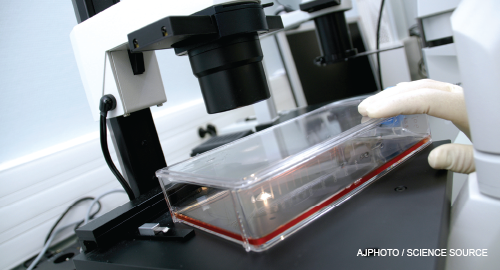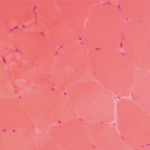When evaluating patients with possible myopathic symptoms, rheumatologists must consider a rare, but important, group of inherited disorders: the metabolic myopathies. However, their diagnosis often remains a challenge. Early recognition of these primary metabolic myopathies is essential to help prevent disease morbidity and mortality from rhabdomyolysis. Here, we focus on the metabolic myopathies that present with primarily non-systemic issues and lead to exercise intolerance with dynamic myopathic symptoms.
Pathophysiology of Metabolic Myopathies
In cells, glucose and free fatty acids provide the main fuels used to produce adenosine triphosphate (ATP), the cell’s main source of energy. The process of glycogenolysis breaks down stored glycogen into a major source of usable
glucose. Through the processes of glycolysis, the Krebs cycle and, ultimately, the mitochondrial respiratory chain, the energy in glucose (4 kcal/g) and in free fatty acids (9 kcal/g) is liberated.1,2
A heterogeneous group of individually rare genetic disorders, metabolic myopathies are primary inborn errors of metabolism (IEM). These disorders impact one or more proteins involved in the intermediary metabolism of glucose and free fatty acids, and most of them reduce the adequate production of ATP. Many bodily systems can be affected by such deficits. However, because muscle tissue is so reliant on high amounts of ATP, especially during exercise, it is particularly susceptible to impact from ATP deficits.2-4
The metabolic myopathies are known for their diversity of phenotype and genotype. These enzyme defects can lead to a variety of presentations, depending on the exact gene affected and the severity of the mutation. More severe mutations tend to affect several organ systems and present in infancy or early childhood with such symptoms as liver disease, cardiomyopathy and encephalopathy. Some mutation types lead to progressive disease with persistent weakness, and sometimes cause additional non-myopathic symptoms as well.1-4
However, some types of mutations lead to partial enzymatic function resulting in milder presentations. People with these types of mutations may have myopathic symptoms only, typically (though not always) non-fixed symptoms that occur in response to exercise or other metabolic stress. Such myopathies can prove challenging diagnostically, revealing exercise intolerance only without any other systemic abnormalities.1-4
Subtypes of Metabolic Myopathies
Metabolic myopathies are generally classified into three main subtypes: defects of glycogen metabolism, disorders of lipid metabolism, and mitochondrial disease.
Glycogen storage diseases

Dr. Tarnopolsky
Impairments in glycogenolysis, glycogen production or of anaerobic glycolysis are often grouped together as the glycogen storage diseases (GSDs). If not enough ATP can be made available to cells via glycolysis and glycogenolysis during intense exercise, cramping and other such symptoms can result.4
Mark Tarnopolsky, MD, PhD, FRCPC, is a professor of pediatrics and medicine in the Division of Neuromuscular and Neurometabolic Disorders at McMaster University, Hamilton, Ontario. He explains that we use specific energy sources during different types of activity: “If you had to go up a flight of stairs or run to catch the bus, the muscle is utilizing mostly glucose or glycogen. If there is glycogen storage disease, then this energy can’t be delivered to the muscle.”
Around half of the more than 20 currently known GSDs manifest with myopathic disease. The most common disorder of glycogen metabolism is also the most common metabolic myopathy overall: McArdle’s disease (GSD-V), whose prevalence is approximately one in 40,000.5
In a minority of disorders, symptoms arise not from problems with the lack of availability of products used for cellular metabolism, but because of structural changes due to the disease process itself. For example, in Pompe disease (GSD-II), the pathology derives from a lysosomal defect that leads to glycogen buildup in the lysosomes. This eventually damages the muscles, resulting in a fixed, progressive myopathy.
Fatty acid oxidation defects
Disorders of fatty acid oxidation and oxidation transport are less common than those of glycogen metabolism. Milder cases of such disorders can also present in adulthood as myalgia and exercise intolerance.6 Of the 18 or so identified genetic defects known to cause disease, around half are thought to cause myopathic symptoms. Carnitine palmitoyltransferase II (CPT II) deficiency is the most common disorder in this group.5
“Longer duration and lower intensity activities rely more heavily on lipid metabolism. These activities can precipitate an energy crisis in a fatty acid oxidation defect [FAOD] or mitochondrial disease,” explains Dr. Tarnopolsky. “[Patients] may [have] symptoms if they went for a two-hour walk and forgot to eat beforehand, if they rented bikes and went for a three-hour bike ride, that sort of stress. Eventually we run out of glycogen in our muscles and start dipping into fat stores.” This starts symptoms in these patients.
Mitochondrial myopathies
Disorders of the mitochondrial chain represent the third group of metabolic myopathies, resulting from problems with the final common pathway for energy derivation. These will often present with similar triggers as FAODs. However, most mitochondrial diseases will cause additional non-myopathic symptoms, as well. Depending on the mutation and severity, these can include diabetes, seizures, hearing loss, stroke and a wide variety of possible neurological symptoms. About one in 8,000 people are affected.1,5


